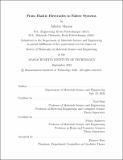From elastic electrodes to fabric systems
Author(s)
Marion, Juliette
DownloadThesis PDF (6.016Mb)
Advisor
Fink, Yoel
Anikeeva, Polina
Terms of use
Metadata
Show full item recordAbstract
Textile-based electronics hold promise for wearable sensors and devices, as well as flexible and conformable electronics. In recent years, research has focused on realizing specific devices or even system level functions within a single fiber. Harnessing thermal drawing, significant developments in fiber functionality have been achieved over the last couple of decades. However, certain essential properties of device containing fibers still require attention. In particular, yarns in an electronic textile must withstand large strains and bending, while maintaining their functional integrity. As metal electrodes are necessary to connect devices over hundreds of meters of fiber, they preclude fiber devices from having the elasticity necessary to sustain weaving, knitting, and daily use.
In this thesis, we investigate the use of in-fiber structural elasticity as a mean to build elasticity in thermally drawn functional fibers. We explore thermal drawing of elastomers and expose how the drawing stress can affect the fibers mechanical properties. We propose two approaches to achieve metal electrodes demonstrating high elasticity (> 10%), through buckling of a metal microwire within a cavity, or through twisting of a fiber to yield helical metal electrodes. We later examine the mechanical constraints involved in weaving and knitting, and enrich the list of principles for fiber design, to limit friction and kinking. We finally devise a method to connect micro-devices in fibers via buckled electrodes, and demonstrate two fabric systems: a woven, three-dimensional optical antenna, and a knitted garment able to detect localized changes in skin temperature.
Date issued
2022-09Department
Massachusetts Institute of Technology. Department of Materials Science and EngineeringPublisher
Massachusetts Institute of Technology